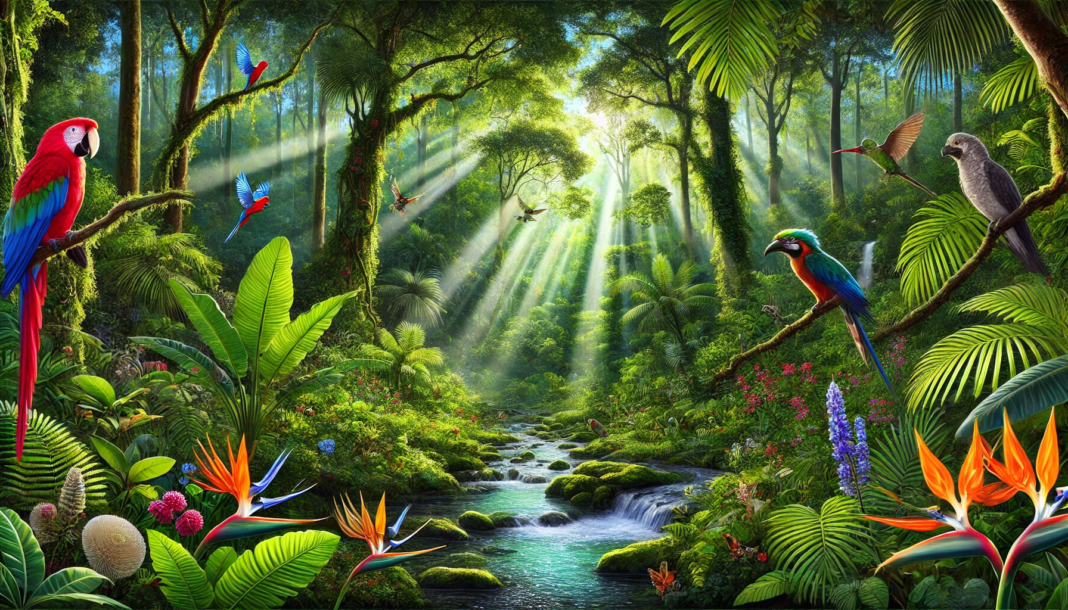The Caribbean is renowned for its stunning beaches, vibrant cultures, and warm, tropical climate. However, the region is also home to some of the most biodiverse tropical rainforests in the world.
These lush, green landscapes are teeming with life, from towering trees and vibrant flowers to a vast array of animal species. The tropical rainforests of the Caribbean are not only a vital component of the region’s natural beauty but also play a crucial role in the global ecosystem.
This article explores the characteristics, biodiversity, and ecological importance of the Caribbean’s tropical rainforests.
Characteristics of Caribbean Tropical Rainforests
Climate and Geography
Caribbean tropical rainforests thrive in regions with warm temperatures, high humidity, and abundant rainfall. These forests are typically found in areas with annual precipitation exceeding 2,000 millimeters (78 inches) and temperatures averaging around 25°C (77°F) year-round. The combination of these climatic conditions creates an ideal environment for the growth of dense vegetation and a rich diversity of plant and animal life.
The geography of the Caribbean islands varies, with some rainforests located on mountainous terrain and others in lowland areas. Notable examples include the El Yunque National Forest in Puerto Rico, the Blue and John Crow Mountains in Jamaica, and the lush rainforests of Dominica. These regions are characterized by their complex ecosystems, which include a variety of microhabitats and ecological niches.
Flora: A Botanical Wonderland
The flora of Caribbean tropical rainforests is incredibly diverse, featuring a wide range of plant species, from towering trees to delicate ferns and vibrant orchids. The forests are structured in distinct layers, including the emergent layer, canopy, understory, and forest floor, each supporting different types of vegetation.
- Emergent Layer: This top layer consists of the tallest trees, which can reach heights of up to 50 meters (164 feet). These trees, such as the kapok tree and mahogany, rise above the canopy, capturing sunlight and providing habitats for various birds and insects.
- Canopy: The canopy is the dense, leafy layer formed by the upper branches of trees. It is home to a wide variety of plants, including epiphytes (plants that grow on other plants) like orchids and bromeliads. The canopy also hosts a rich diversity of wildlife, such as monkeys, birds, and insects.
- Understory: Below the canopy, the understory receives limited sunlight, resulting in smaller trees and shrubs. This layer is rich in ferns, palms, and woody vines, creating a lush and diverse environment.
- Forest Floor: The forest floor is shaded and moist, covered with leaf litter, decaying wood, and a variety of fungi. This layer is home to a range of decomposers, such as insects and microorganisms, which play a crucial role in nutrient cycling.
Fauna: A Biodiversity Hotspot
The tropical rainforests of the Caribbean are home to an extraordinary variety of animal species, many of which are endemic to the region. The fauna includes a wide range of mammals, birds, reptiles, amphibians, and insects, each adapted to the unique conditions of their environment.
Mammals
Caribbean rainforests host several mammal species, including the Jamaican hutia, a rodent found only in Jamaica, and the Solomon Island flying fox, a type of bat native to the region. Bats, in particular, are crucial for pollination and seed dispersal, playing a vital role in the health of the ecosystem.
Birds
Birdlife in the Caribbean rainforests is exceptionally diverse, with numerous species of parrots, hummingbirds, and raptors. The Puerto Rican parrot, one of the most endangered birds in the world, is found in the El Yunque National Forest. Other notable species include the Jamaican tody, Antillean crested hummingbird, and the St. Vincent amazon parrot.
Reptiles and Amphibians
The Caribbean’s rainforests are home to a variety of reptiles and amphibians, including several species of frogs, lizards, and snakes. The Cuban tree frog and the Puerto Rican crested anole are examples of species adapted to the humid, forested environment. The region is also known for its endemic gecko and iguana species.
Insects and Other Invertebrates
Insects and other invertebrates play a critical role in the Caribbean rainforests’ ecosystem. The forests are teeming with butterflies, beetles, ants, and spiders, each contributing to pollination, decomposition, and the food web. The diversity of invertebrates is a testament to the complexity and richness of these ecosystems.
Ecological Importance and Benefits
Biodiversity and Conservation
The tropical rainforests of the Caribbean are biodiversity hotspots, harboring a vast array of species, many of which are endemic and not found anywhere else in the world. This biodiversity is crucial for the stability and resilience of ecosystems, as it allows for a wide range of ecological interactions and processes.
Conservation efforts are vital to protect these unique ecosystems from threats such as deforestation, habitat fragmentation, and climate change. Several Caribbean countries have established national parks and protected areas to safeguard their rainforests and the species that inhabit them. These conservation initiatives not only protect biodiversity but also preserve the cultural and natural heritage of the region.
Climate Regulation and Carbon Sequestration
Caribbean tropical rainforests play a significant role in regulating the global climate by acting as carbon sinks. The dense vegetation absorbs carbon dioxide from the atmosphere, storing carbon in biomass and soil. This process helps mitigate the effects of climate change by reducing the concentration of greenhouse gases in the atmosphere.
Additionally, rainforests influence local climate patterns by regulating temperature and humidity. The transpiration of water from plant leaves contributes to cloud formation and precipitation, maintaining the hydrological cycle and supporting the water needs of surrounding areas.
Ecosystem Services and Resources
The rainforests of the Caribbean provide numerous ecosystem services and resources that benefit local communities and the broader region. These services include:
- Water Regulation: Rainforests help maintain the quality and availability of freshwater resources by filtering and purifying water, regulating streamflow, and preventing soil erosion.
- Medicinal Plants: The forests are a valuable source of medicinal plants used in traditional medicine and modern pharmaceuticals. Many plants in the Caribbean rainforests have potential therapeutic properties, making them essential for healthcare and research.
- Tourism and Recreation: The natural beauty and biodiversity of the Caribbean rainforests attract tourists and nature enthusiasts, contributing to the region’s economy. Ecotourism activities, such as hiking, birdwatching, and guided tours, provide opportunities for visitors to experience and appreciate the unique ecosystems.
Threats to Caribbean Tropical Rainforests
Despite their ecological importance, Caribbean tropical rainforests face several threats that endanger their health and sustainability. Some of the primary threats include:
Deforestation and Habitat Loss
Deforestation, driven by agriculture, logging, and urban development, is one of the most significant threats to the region’s rainforests. The removal of trees and vegetation disrupts ecosystems, reduces biodiversity, and leads to habitat loss for many species. Efforts to curb deforestation and promote sustainable land-use practices are crucial for preserving these vital ecosystems.
Climate Change
Climate change poses a significant threat to the Caribbean’s rainforests, affecting temperature, rainfall patterns, and sea levels. Changes in climate can alter the distribution of species, disrupt ecological processes, and increase the frequency of extreme weather events. Adaptation and mitigation strategies are essential to protect the region’s rainforests and their inhabitants.
Invasive Species
Invasive species, introduced either intentionally or accidentally, can outcompete native species and disrupt ecosystems. In the Caribbean, invasive plants, animals, and pathogens threaten the delicate balance of rainforest ecosystems, leading to biodiversity loss and ecological degradation. Managing invasive species and restoring native habitats are critical components of conservation efforts.
Pollution
Pollution, including plastic waste, chemicals, and air pollution, negatively impacts the health of rainforest ecosystems. Contaminants can harm plants and animals, degrade water quality, and reduce the overall resilience of the ecosystem. Reducing pollution through regulations, education, and sustainable practices is essential for protecting the region’s natural resources.
Conclusion
The tropical rainforests of the Caribbean are a vital part of the region’s natural heritage, offering a rich tapestry of biodiversity and ecological benefits. These lush landscapes are home to a diverse array of plant and animal species, many of which are found nowhere else in the world. The rainforests play a crucial role in regulating the climate, providing ecosystem services, and supporting local communities. However, they also face numerous threats that require concerted conservation efforts to ensure their protection and sustainability. By valuing and preserving these unique ecosystems, we can safeguard the Caribbean’s natural legacy for future generations.
FAQs
What are some of the most significant tropical rainforests in the Caribbean?
Notable tropical rainforests in the Caribbean include the El Yunque National Forest in Puerto Rico, the Blue and John Crow Mountains in Jamaica, and the rainforests of Dominica. These areas are known for their rich biodiversity and unique ecosystems.
Why are tropical rainforests important for the global climate?
Tropical rainforests play a crucial role in regulating the global climate by acting as carbon sinks. They absorb carbon dioxide from the atmosphere, reducing greenhouse gas concentrations and helping mitigate climate change. Additionally, rainforests influence local climate patterns and contribute to the hydrological cycle.
What are some common threats to Caribbean tropical rainforests?
Common threats to Caribbean tropical rainforests include deforestation, climate change, invasive species, and pollution. These factors can lead to habitat loss, biodiversity decline, and ecosystem degradation.
How can we protect the tropical rainforests of the Caribbean?
Protecting the tropical rainforests of the Caribbean involves conservation efforts such as establishing protected areas, promoting sustainable land-use practices, managing invasive species, and reducing pollution. Public education and awareness are also essential for fostering a sense of stewardship and encouraging responsible behavior.
What types of animals are found in Caribbean tropical rainforests?
Caribbean tropical rainforests are home to a diverse range of animals, including mammals (e.g., bats, rodents), birds (e.g., parrots, hummingbirds), reptiles (e.g., lizards, snakes), amphibians (e.g., frogs), and a variety of insects and other invertebrates.
How do tropical rainforests benefit local communities in the Caribbean?
Tropical rainforests provide numerous benefits to local communities, including water regulation, resources such as medicinal plants and timber, and opportunities for ecotourism and recreation. These ecosystems also support agriculture and fisheries by maintaining soil fertility and water quality.

